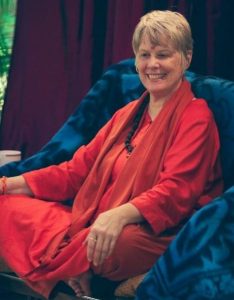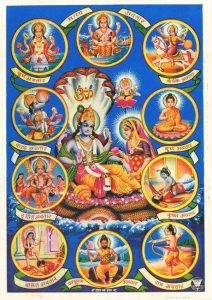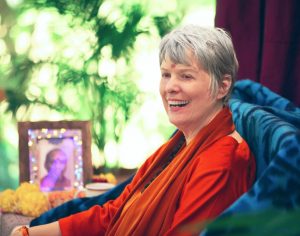 By Swami Nirmalananda
By Swami Nirmalananda
A bird flaps its wings to take off and gain height, working hard to overcome the pull of gravity. Then it finds air currents and just floats through the air. It’s so wonderful to watch it soaring overhead, wings extended wide as it surfs the air-stream. Sometimes you can see it dip one wing or angle its tail feathers to navigate in a different direction; it takes only a minimal movement to create a significant change in trajectory. This is not hard work! Birds know how to use the wind beneath their wings. You need to find the same thing — that which lifts and supports you from inside.
Using yoga to investigate your feelings is a process of becoming lighter and freer, like a bird. Everything about a bird is engineered to be light, so it can float on the breeze; even the bones of a bird are hollow so it can fly more easily. With your own inner state, when you first feel an internal disturbance, you can recognize that an emotion or feeling is stirring up. This is an internal heaviness. You can practice the “yoga of emotions” by:
- feeling the feeling,
- finding the desire that creates it, and
- releasing the desire.
When you practice this yogic release, you become progressively lighter and lighter. Your old emotional set-point lifts to a new level.
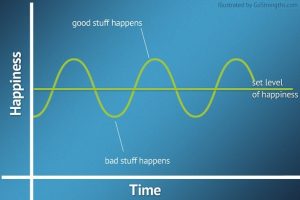 Most people take it for granted that life will be an endless series of ever-changing moods, described as “normal ups and downs.” Charted on a graph, you might see as much above the axis as below and even wish for balance by having the two be equal. Thus, your times of feeling extra-good would balance out with your times of feeling extra-bad, and most of the time you live somewhere in the middle. That’s your emotional set-point, neither happy nor sad. Fortunately, yoga promises much more than a normal person could ever hope for.
Most people take it for granted that life will be an endless series of ever-changing moods, described as “normal ups and downs.” Charted on a graph, you might see as much above the axis as below and even wish for balance by having the two be equal. Thus, your times of feeling extra-good would balance out with your times of feeling extra-bad, and most of the time you live somewhere in the middle. That’s your emotional set-point, neither happy nor sad. Fortunately, yoga promises much more than a normal person could ever hope for.
Life does guarantee that you will have many different kinds of experiences, all of which are opportunities to feel. Your moods do go up and down, above and below your emotional set-point. Some people experience a greater range of ups and downs than others. It is important that your range, both going above and below the set-point, should not be too small — or you are shutting off your own feelings. This is called repression and denial. It is also important that your range not be too big, as you live on an emotional roller coaster. This is actually an addiction, one that is very hard to cure. Yet you don’t want life to be a flat-line either.
 Researchers looked into the well-accepted psychological theory that every person has an emotional set-point. According to this theory, you have life experiences that make you feel wonderful, and then you drop back down to your own individual set-point. At other times, you feel terrible but you return to your set-point again. This set-point (the theory says) is uniquely yours and remains unchanged throughout your life, with some people being innately happier and others living on the edge of despair. Somebody recently gave me a sheet of Winnie the Pooh stickers — Eeyore has a very different individual set-point than Tigger.
Researchers looked into the well-accepted psychological theory that every person has an emotional set-point. According to this theory, you have life experiences that make you feel wonderful, and then you drop back down to your own individual set-point. At other times, you feel terrible but you return to your set-point again. This set-point (the theory says) is uniquely yours and remains unchanged throughout your life, with some people being innately happier and others living on the edge of despair. Somebody recently gave me a sheet of Winnie the Pooh stickers — Eeyore has a very different individual set-point than Tigger.
These researchers had different groups doing different things that might affect their set-point, including one group who did yoga and meditation. You will not be surprised at the results, though the scientists were — the yogis’ set-point changed. The researchers described clearly that this was not a temporary high that the yoga-subjects were feeling — their emotional set-point was lifted up a few points, a permanent change.
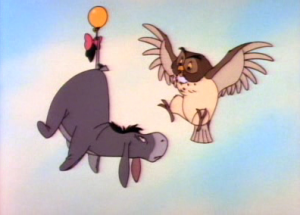 Yoga describes its goal as a steady state of illumined insight and bliss, called sthita-praj~na (stih-taw praj-nya) in the Bhagavadgita. Eeyore has a steady state, but it is not sthita-praj~na. He is consistently unhappy, the confirmed pessimist. His state is steady but not one of bliss. Tigger also has a steady state, but not sthita-praj~na. He is consistently giddy, unabashedly enthusiastic regardless of what is going on or how other people are reacting. His state is happy but not sthita-praj~na. It is ignorant bliss. Sthita-praj~na is not ignorant. It is a constant wind beneath your wings, an inner experience of knowing and blissful-beingness that is always supporting you from inside.
Yoga describes its goal as a steady state of illumined insight and bliss, called sthita-praj~na (stih-taw praj-nya) in the Bhagavadgita. Eeyore has a steady state, but it is not sthita-praj~na. He is consistently unhappy, the confirmed pessimist. His state is steady but not one of bliss. Tigger also has a steady state, but not sthita-praj~na. He is consistently giddy, unabashedly enthusiastic regardless of what is going on or how other people are reacting. His state is happy but not sthita-praj~na. It is ignorant bliss. Sthita-praj~na is not ignorant. It is a constant wind beneath your wings, an inner experience of knowing and blissful-beingness that is always supporting you from inside.
As you practice the yoga of emotions, you begin to see that you really have choice about the way you feel. Untangling the knotted threads of your emotions is a process of becoming light and free on the inside. This experience is promised in the yoga texts. You will be set free from the trap of your emotions, whether you want to be or not.
“I don’t want to give up my downs,” a yoga student said to me. “I don’t want to be happy all of the time.” I was amazed that she would say this. As I questioned her, it became clear that she believed that you can only go as far upward as you go down. She feared that giving up the “downs” meant she would have to give up the “ups.” In yoga, it really doesn’t work that way. Remember the people in the research study: their emotional set-point went up. What would happen if they did yoga for more than the short time period of the study; do you think it would continue to rise?
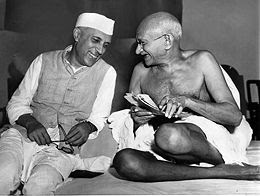 Mahatma Gandhi’s favorite part of the Bhagavadgita was the last part of the second chapter. He had the last 19 verses read aloud every afternoon in his Ashram (residential yoga community). They describe one who lives in a steady state, sthita-praj~na.
Mahatma Gandhi’s favorite part of the Bhagavadgita was the last part of the second chapter. He had the last 19 verses read aloud every afternoon in his Ashram (residential yoga community). They describe one who lives in a steady state, sthita-praj~na.
When you release all the desires your mind can conjure up and turn your attention inward, you will be filled by your own inherent Inner Divinity. Such a yogi is sthita-praj~na, one who is established in illumined insight and bliss. (2.55)*
The text goes on to describe this steady state as being:
- indifferent to happiness
- free from need, fear and anger
- untroubled by unfavorable results
- not elated by getting desired results
- not affected by praise or blame (2.56-57)*
Unfortunately, this can be easily misunderstood and sound like someone who is cold, distant, clinically depressed, withdrawn or even dissociated. None of this is what the text means. Further lines in this section make it clear:
All your suffering is destroyed and you become profoundly joyful and deeply peaceful. Your state becomes completely steady in this inner joy and peace. (2.65)
This is not a description of someone who has withdrawn from other people and the world. It is a profound promise that you can live with your heart and your eyes open. You see the world as it really is, not recoiling from the truth, nor lusting after something that will provide you with temporary satisfaction while leaving that deeper “itch” unscratched. This is about raising your emotional set-point to a level higher than you can currently imagine.
 However good you can imagine that it can be, it gets better. The constant arising of bliss supports your steady state in the inside (sthita-praj~na). It is further supported by your constant recognition of others as many different expressions of the One Reality that is your own Self. Each moment is a divine reunion of Self meeting Self in all its various disguises.
However good you can imagine that it can be, it gets better. The constant arising of bliss supports your steady state in the inside (sthita-praj~na). It is further supported by your constant recognition of others as many different expressions of the One Reality that is your own Self. Each moment is a divine reunion of Self meeting Self in all its various disguises.
You must know and remember that there is a goal. Remember where you are headed, just like if you get in your car for a drive — don’t take the wrong turn. You really do have a choice. Yoga gives you the power of that choice. You have so many tools that you can use:
- Sit or stand in a yoga pose, or even take a few minutes for a Shavasana break.
- Use two or three Ujjayi breaths to get a “reset” whenever you need it.
- Look at your emotions, and let go of the desire hidden inside of them.
- Practice contentment — becoming at ease with what is really happening, even if it is not what you thought you wanted.
- Surrender — ending the efforting/straining and “go with the flow.”
- Live in the Presence — of your own Divine Essence, or the presence of the Divine in any form you can relate to.
- Silently repeat a mantra or a familiar (short) prayer. Repeat it many times.
- Allow yourself to receive the Grace that is always surrounding and supporting you — the wind beneath your wings.
While you remember the goal, you must also understand that this is a process. When you realize that you have gotten lost in your feelings again, just keep putting one foot in front of the other. Do more yoga.
Originally published September 2003
 As I sat there, I experienced a strange sensation uprising within me — a dawning realization that there was something underneath all the turmoil. It was an amazing inner feeling of continuity. In that moment, everything changed. I knew, in all of the precipitous changes I had been through, something deeper had been there all along. The one constant, in the midst of all those changes, was me — I was there.
As I sat there, I experienced a strange sensation uprising within me — a dawning realization that there was something underneath all the turmoil. It was an amazing inner feeling of continuity. In that moment, everything changed. I knew, in all of the precipitous changes I had been through, something deeper had been there all along. The one constant, in the midst of all those changes, was me — I was there. Wow! What if I did the practices that the sages recommend? Might I find the “more” that they promise? And maybe even without all the pain I’d been using to prompt my transformations?
Wow! What if I did the practices that the sages recommend? Might I find the “more” that they promise? And maybe even without all the pain I’d been using to prompt my transformations?





